The Token and Atlantic Souvenir, An Offering for Christmas and the New Year is a 19th-century illustrated gift book. Gift books were popular in the nineteenth century and contained illustrations, short essays, stories, and poems, most often given to women as gifts during the holidays. People typically looked at and displayed gift books, but they did not read them all the way through like a novel. This work is a first edition, published in 1842 by David H. Williams in Boston, Massachusetts. Different companies published new editions of this book annually, beginning in 1829. Originally, The Token and The Souvenir were separate books, but the publishers merged them in 1833 to become The Token and Atlantic Souvenir, which they published yearly until 1842.
The elegant look, from the art on the covers to the gilded pages, drew me in. The book has a red leather cover with embossed artwork of a girl holding a painting of a soldier and a flag, sitting next to an eagle with grand architecture in the background. Around the border and spine, there are swirls with flowers and vines. The pages of the book are also gilded around the edges, with gold leaf lettering on the spine. Despite the book’s age, there is not much damage, only wear and tear from years of use. The fabric on the cover is torn at the spine and around the edges, revealing the boards used to build the covers. The binding is mostly intact, though the glue seems to be pulling apart, leaving a few pages loose from the spine. Overall, the book seems to be very well-crafted, with many years of use; this book was well-loved.
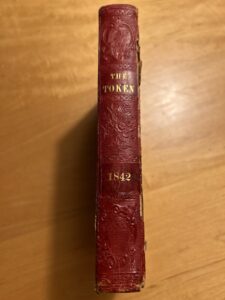
Figure 1: The Spine
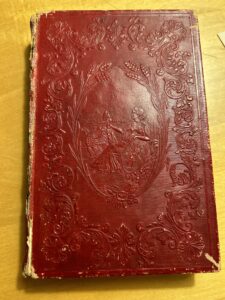
Figure 2: Front Cover
There are two title pages in this book. The first one, which is much more ornate, has two illustrations; one on the left page titled “The Bracelet” and one underneath the title, portraying a porch with a pot, flowers, a painting, and a lady walking up the stairs. The title on this page simply says, “The Token,” and the script is drawn, rather than written.
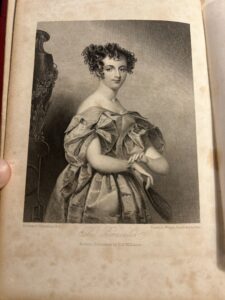
Figure 3: The Bracelet
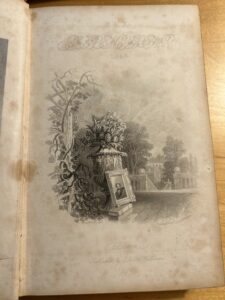
Figure 4: Illustrated Title Page
The second title page displays the full title, The Token and Atlantic Souvenir, An Offering for Christmas and the New Year. It contains information on the publisher of the book, including the years and location of the different companies.
One interesting thing about this book is how it lists out the different companies that published the book, all located in different cities. David H. Williams, the publisher of this particular copy, was a notable publisher that established his own firm in the 1830s. Thomas Cowperthwaite & Co. was known for publishing educational and geographical materials, including atlases and schoolbooks; Henry Perkins worked on religious, educational, and illustrated works. Both publishers were located in Philadelphia, and it’s possible that they collaborated for regional distribution of the book. Collins, Keese & Co. was a New York-based publishing firm during the 19th century, which published a wide range of materials, from Bibles and schoolbooks to gift books and literary works. Cushing & Brothers was a publishing and bookselling firm based in Baltimore. The company was most known for producing religious, educational, and literary works. U.P. James Publishing was a notable publishing company based in Cincinnati, Ohio, which specialized in historical works, novels, educational materials, and popular literature, as well as early American editions of English works and reprints of popular literature. J.C. Dennies & Co. Publishing was a publishing firm based in St. Louis, which was emerging as an important regional hub for trade and culture during this period. Wiley & Putnam was a prominent Anglo-American publishing partnership formed between John Wiley (of New York) and George Palmer Putnam (of London), making them one of the first transatlantic publishing firms. Their focus was to bring British works to America and American works to Britain. Jules Renouard Publishing was a notable French publishing house based in Paris, most known for publishing scholarly works, literary collections, and historical materials. The various publishers were all located in vastly different cities, many of which were centers of culture and commerce; so many different companies all publishing the same book would have expanded its reach.
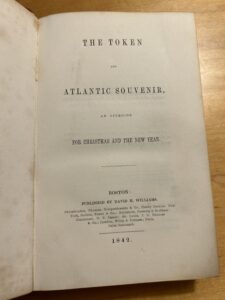
Figure 5: Title Page
Following the title page, there is a preface, a table of contents, and an embellishments page. The preface discusses the authors and the publication details, describing the copyrighted works. The table of contents lists the poetry and stories by page, so readers can find specific texts. The embellishments page provides information on the authors and artists, crediting each to their specific work.
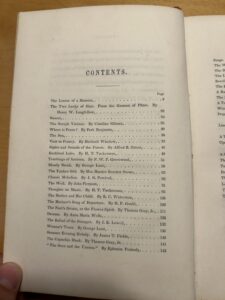
Figure 6: Table of Contents
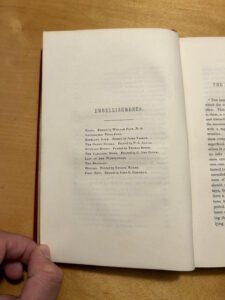
Figure 7: Embellishments
The book contains many black and white illustrations paired with the poems. There are ten pictures in the book, including the two on the title pages. Each illustration has a piece of tissue paper in front of it to protect it. Surrounding the other eight illustrations, the pages have stains of yellowing, most likely due to the oxidation of the chemicals in the ink of the pictures. Each picture accompanies a poem on the next page.
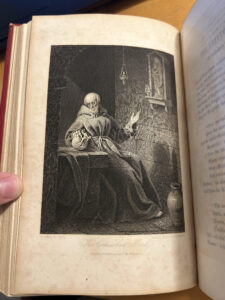
Figure 8: The Capuchin Monk Illustration
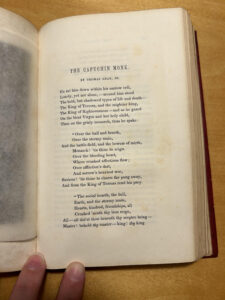
Figure 9: The Capuchin Monk Prose
Many of the pages contain poems, so they have a title at the top, with the stanzas underneath. The poetry and prose are left-oriented. The typefaces used throughout the book were difficult to identify, but I was able to find close matches through the app What the Font. For the title in the top margins, the font is similar to Boston 1851; the titles of each poem look like Consort Trade; in the poems and other paragraphs, the font is most likely Scotch Roman, as the printer of this book, Samuel N. Dickinson, introduced this typeface in the U.S.
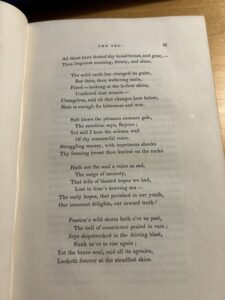
Figure 10: The Sea Prose
When I hold the book, it feels very solid, as it is relatively heavy. The pages don’t stay open as I hold it, so I must hold them open when both hands or the book will fall shut. The pages do not fall open to any specific page. Due to the embossment on the front and back covers, they are textured and feel bumpy under my hands. I feel like I need to be more careful with it, as the fabric laid over the cover is cracking away where the book bends at the spine.
I was also able to find information on many of the people that went into creating the book. The paper makers were J.M. and L. Hollingsworth, who were based in Massachusetts, and considered pioneers in the paper industry in the 19th century. The printer was Samuel N. Dickinson, who established the Dickinson Type Foundry. The binder was Benjamin Bradley, who was a renowned case cloth binder in New England. Lastly the engravers were Rawdon, Wright, Hatch, and Smillie, which was an engraving firm known for creating finely detailed illustrations. They helped set the standard for engraved works in the 19th century.
It is unusual for books to name those that built the book, as people often overlook these practices. As many people collected gift books, their appearance typically determined their value. Naming those that helped build the book may have emphasized the collaboration that went into making the book special, adding prestige to a collection.

Figure 11: Bradley Binder Embossment
The inside end pages are pink paper and have clear signs of foxing. On the back endpaper, there is a pencil mark, though I was unable to make out what it says or means. It is possible that the marking is someone’s initials, as it seems to be two or three letters in cursive.
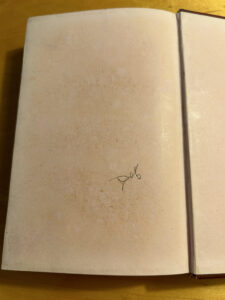
Figure 12: Pencil marking on inside cover
Works Consulted
“ HathiTrust Digital Library.” Hathitrust.org, 2024, catalog.hathitrust.org/Search/Home?lookfor=%22Perkins%2C+Henry+1803-1889%22&type=author&inst=. Accessed 9 Oct. 2024.
“Details For: The Token and Atlantic Souvenir, : An Offering for Christmas and the New Year. › Library Company of Philadelphia Catalog.” Kohacatalog.com, 2024, librarycompany.kohacatalog.com/cgi-bin/koha/opac-detail.pl?biblionumber=277999. Accessed 9 Oct. 2024.
“Essay on Our Benjamin Bradley Bindings – the Library Company of Philadelphia.” Librarycompany.org, 2024, librarycompany.org/2015/04/16/essay-on-our-benjamin-bradley-bindings/. Accessed 9 Oct. 2024.
“Flash of the Comet: The Typographical Career of Samuel N. Dickinson on JSTOR.” Jstor.org, 2024, www.jstor.org/stable/40371675. Accessed 9 Oct. 2024.
“G. P. Putnam and Sons Correspondence an Inventory of the Collection at Syracuse University.” Syracuse.edu, 2024, library.syracuse.edu/digital/guides/g/g_p_putnam.htm#d2e90. Accessed 9 Oct. 2024.
“G. P. Putnam’s Sons (New York & London) | Organisations | RA Collection | Royal Academy of Arts.” Royalacademy.org.uk, 2024, www.royalacademy.org.uk/art-artists/organisation/g-p-putnams-sons-new-york-and-london. Accessed 9 Oct. 2024.
“Jules Renouard (1798-1854).” Data.bnf.fr, 2024, ark:/12148/cb153762313. Accessed 9 Oct. 2024.
“Rare Gift Books.” Brandeis.edu, 2024, www.brandeis.edu/library/archives/essays/special-collections/rare-gift-book.html. Accessed 9 Oct. 2024.
The. “Token Atlantic Souvenir by Longfellow Henry Wadsworth Stowe – AbeBooks.” Abebooks.com, 2024, www.abebooks.com/book-search/title/token-atlantic-souvenir/author/longfellow-henry-wadsworth-stowe/. Accessed 9 Oct. 2024.
“The Token and Atlantic Souvenir : An Offering for Christmas and the New Year | WorldCat.org.” Worldcat.org, 2024, search.worldcat.org/title/33211632. Accessed 9 Oct. 2024.
Leave a Reply